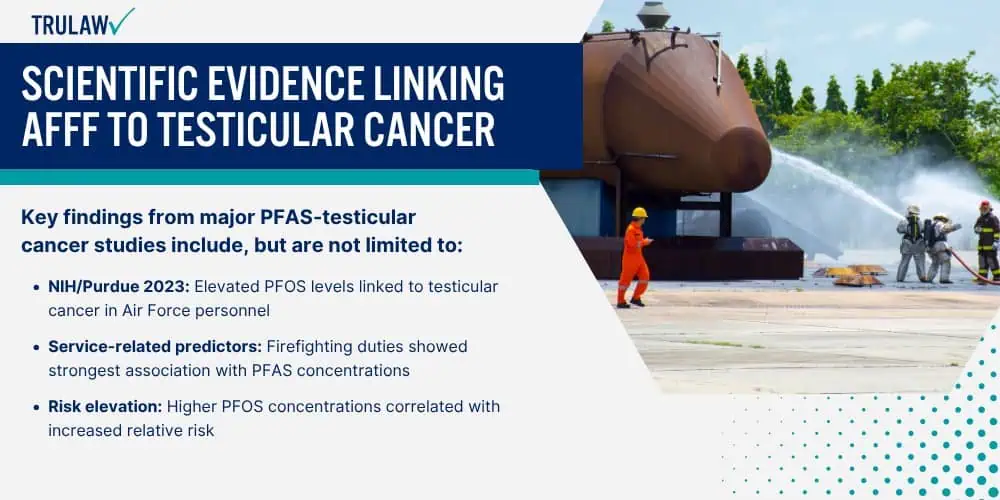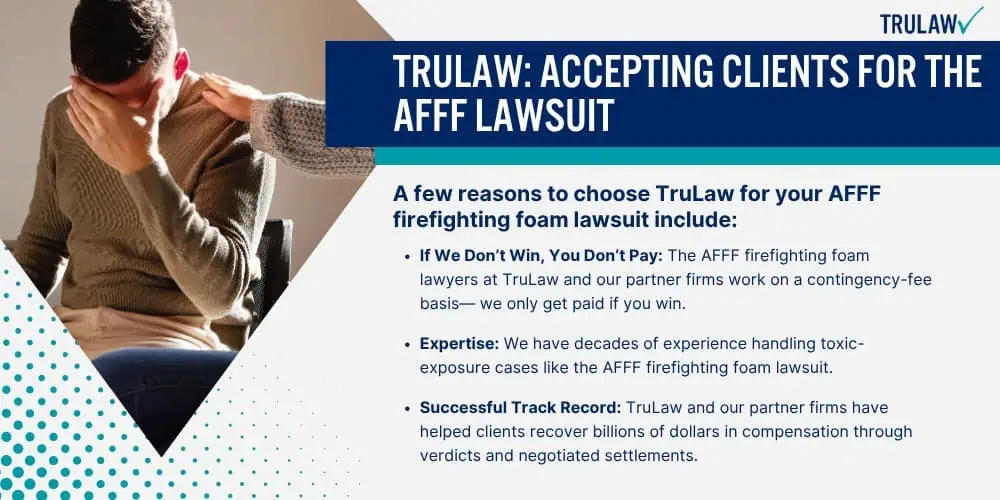Aqueous Film-Forming Foam (AFFF) contains per- and polyfluoroalkyl substances (PFAS), synthetic chemicals used extensively in firefighting operations since the 1960s at military installations, airports, and industrial facilities worldwide, leading to numerous AFFF firefighting foam cases.

These “forever chemicals” persist indefinitely in both the environment and human body, with mounting scientific evidence specifically linking PFAS exposure to elevated testicular cancer rates among firefighters and military personnel who regularly handled this firefighting foam, as well as increased risks of thyroid disease.
What Makes AFFF Dangerous to Human Health
PFAS chemicals, particularly perfluorooctane sulfonate (PFOS) and perfluorooctanoic acid (PFOA), persist in human tissue because they resist natural breakdown processes, accumulating with half-lives ranging from 2.9 years for PFOS to 3.8 years for PFOA, making them some of the most persistent toxic chemicals known to science.
These synthetic compounds bind to proteins in blood plasma and concentrate in organs throughout the body, disrupting normal biological functions in those regularly exposed to firefighting foam.
The primary health impacts of PFAS exposure include, but are not limited to:
- Endocrine system disruption affecting hormone production and regulation
- Immune system suppression reducing the body’s ability to fight disease
- Cellular damage at the DNA level potentially triggering cancerous mutations
- Reproductive system dysfunction affecting fertility and hormone balance
- Metabolic disruption impacting cholesterol levels and liver function
PFAS chemicals accumulate preferentially in reproductive tissues where they interfere with testosterone signaling and other hormonal pathways important to normal cellular function, particularly from AFFF foam exposure.
The carbon-fluorine bonds in these compounds create extraordinary stability, preventing the body’s natural detoxification processes from eliminating them effectively, contributing to increased prostate cancer risk.
Who Faces the Highest Risk of AFFF Exposure
Military personnel stationed at over 700 contaminated bases across the United States face particularly high exposure risks, along with civilian firefighters who used AFFF during training exercises and emergency responses, with many now developing testicular cancer.
Airport workers, industrial facility employees, and chemical plant operators who handled or were present during AFFF deployment also experienced occupational exposure to these toxic substances, leading experienced AFFF lawyers to pursue compensation for victims.
High-risk populations and exposure scenarios include:
- Military firefighters: Regular training exercises and aircraft fire suppression
- Civilian firefighters: Municipal and industrial fire response operations
- Airport personnel: Aircraft rescue and firefighting operations
- Navy veterans: Shipboard firefighting systems containing AFFF
- Base residents: Living quarters near fire training areas
- Maintenance workers: Cleaning and servicing firefighting equipment
Residential communities near military installations, airports, and industrial facilities face ongoing exposure through contaminated groundwater and soil, resulting in kidney cancer cases and other serious illnesses.
The Environmental Working Group has documented PFAS contamination affecting drinking water supplies for millions of Americans, with concentrations often exceeding federal safety guidelines by large margins, following decades of AFFF firefighting foam exposure.
The Testicular Cancer Connection Explained
Testicular cancer predominantly affects young men between the ages of 15 and 35, making it the most common cancer diagnosis in this demographic, with firefighters and military personnel showing substantially higher incidence rates compared to the general population, leading to numerous AFFF foam lawsuits.
Research indicates that PFAS exposure disrupts normal testosterone production and interferes with reproductive hormone signaling pathways important for healthy testicular function, as AFFF manufacturers like Tyco Fire Products continued selling these products despite knowing the risks.
Risk factors and warning signs associated with AFFF or PFAS-related testicular cancer include:
- Occupational AFFF exposure lasting one year or more
- Testicular lumps, swelling, or hardness
- Dull aching in the lower abdomen or groin
- Sudden fluid collection in the scrotum
- Breast tenderness or growth (hormonal changes)
- Early diagnosis typically between ages 20-40
PFAS chemicals bind to androgen receptors in testicular tissue, mimicking or blocking natural testosterone activity and potentially triggering abnormal cell growth that develops into malignant tumors, supporting kidney cancer claims as well.
These compounds’ endocrine-disrupting properties interfere with the delicate hormonal balance required for normal testicular cell division and differentiation, presenting serious health risks to exposed individuals.
If you or a loved one developed testicular cancer after AFFF exposure during military service or firefighting duties, you may be eligible to seek compensation through firefighting foam cancer lawsuits.
Contact TruLaw using the chat on this page to receive an instant case evaluation and determine whether you qualify to join others in filing an AFFF lawsuit today.






